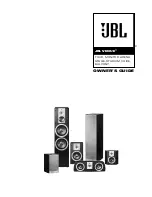
13
THEORY OF OPERATION
3.4 Decoder Gain Cell (Refer to Schematic sheet 2)
The output of the treble control stage is applied to the input of the surround sound decoder.
The decoder is made up of several stages that include U10, U11, U12, and U14. At the input of
the decoder, left and right audio channels are converted to L+R and L-R signals through
summing amplifier U10, pins 1, 2 and 3 and differential amplifier U10, pins 12, 13 and 14,
respectively.
The L+R (center) and L-R (surround) channels are applied to a dual current controlled amplifier
U11 ( CA3280 operational transconductance amplifier). This IC is the heart of the decoder, as
its momentary gain determines how the signal is steered (added or subtracted) into the various
output channels. The gain of this amplifier is directly proportional to the current flowing into pin
3 (labeled I1 on the schematic), and inversely proportional to the current flowing into pin 1
(labeled I4 on the schematic). Unlike a typical op-amp, the output of a transconductance
amplifier is a current, not a voltage. However, in effect, it is converted to a voltage when it flows
through the fixed parallel load resistor (R507 or R407) for the bottom amplifier.
It is important to understand how this gain block operates for specific audio input conditions.
Consider the case of a mono input signal. The |L|-|R| current source (I1) will equal zero and
therefore the gain of center amplifier U11 will be zero (no output at U11, pin 13). Thus, the path
for the audio signal at U10, pin 1 will be only through inverting amplifier U10 (pins 5, 6 and 7)
and the L+R signal will pass forward. Likewise, the gain at surround amplifier U11, pin 12 will
be zero, but the L-R signal (at U10, pin 14) that is allowed to independently pass forward
through the inverting input of differential amplifier U10 is equal to zero, and therefore no output
occurs.
Consider the case of an L=-R input signal (pure surround). The |L|-|R| current source will again
be zero because the value of this current is the difference between the average amplitude (not
phase) level of each of the two channels. So once again the gain of amplifier U11, pin 13 is
zero. But, in this case, the L+R audio signal at U10, pin 1 will be zero, and therefore the net
result is that no signal occurs at U10, pin 7. The same gain block is used in the surround
channel, and likewise, for an L=-R signal, U11, pin 12 will be zero, but since there is L-R audio
at U10, pin 14, it is inverted to the output of U10, pin 8.
Consider now the case of a left only or right only input signal. The ||L|-|R|| and |L|+|R| current
sources (I1 and I4) are equal. The gain of the circuit has been designed such that when I1 and
I4 currents are equal, the output signal at pin 13 is 1/2 times the output signal at U10, pin 1. In
other words, the gain of amplifier U11 is -6.0dB. This signal is then amplified by 6dB at U10
pins 5, 6 and 7 and exactly cancels with the inverting signal from U10, pin 1. Therefore, the
overall result is that there is no output at U10, pin 7 and no L+R audio is allowed to pass. The
same action occurs for the gain cell made up of U11, pins 9, 10 and 12 and U10 pins 8, 9 and
10 in the surround channel.
3.5 Decoder Matrix (Refer to Schematic sheet 2)
The L+R output at U10, pin 1 and the output of the Center and Surround gain cells (U10, pin 8)
are differentially summed into the bass channel path at U300, pins 12, 13 and 14. In-phase
bass is positively summed, and out of phase bass is inversely summed.














































